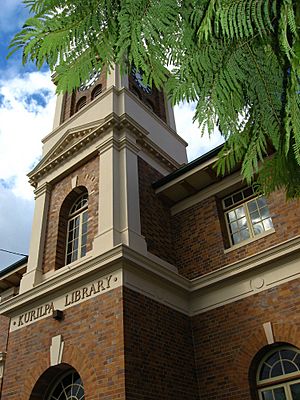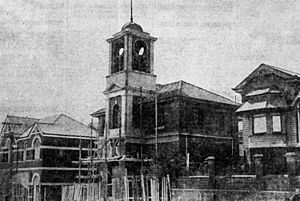Kurilpa Library facts for kids
Quick facts for kids Kurilpa Library |
|
|---|---|

Kurilpa Library, 2005
|
|
| Location | 178 Boundary Road, West End, City of Brisbane, Queensland, Australia |
| Built | 1923 |
| Official name: Kurilpa Library | |
| Type | state heritage (built) |
| Designated | 5 February 2007 |
| Reference no. | 602461 |
| Significant period | 1920s |
| Lua error in Module:Location_map at line 420: attempt to index field 'wikibase' (a nil value). | |
The Kurilpa Library, also known as the West End Library, is a special building in West End, Brisbane, Australia. It's located at 178 Boundary Road. This two-storey brick building has a tall clock tower that stands out on the main street. It was built in 1929 and is considered a heritage-listed site, meaning it's an important part of Queensland's history. It was added to the Queensland Heritage Register on 5 February 2007.
Contents
A Brief History of Libraries
Libraries run by city councils are quite new in Queensland. Most of them started after the 1940s. Before that, places called Schools of Arts or Mechanics' Institutes offered books. People usually paid a small fee to borrow books from these places.
Schools of Arts began in Britain in the early 1800s. Their goal was to help people learn and grow by offering lectures, classes, and lending libraries. Books were very expensive back then, so these places were important for education and fun.
Local councils sometimes helped fund these Schools of Arts. In 1878, a law allowed councils to create their own libraries. However, this didn't happen very often until the 1900s.
Building the Kurilpa Library
The Kurilpa Library was the first public library in Queensland funded by a city council. Soon after, the South Brisbane Library also opened. Councils became more involved in building libraries after the Libraries Act was passed in 1943. This law helped improve library services across the state.
The area of South Brisbane used to be its own city. But in 1925, it joined with other local areas to form the Brisbane City Council. The South Brisbane Council really wanted to build a library in West End. The West End School of Arts committee had asked for money to build a new library.
Alderman Ernest Barstow, who represented the Kurilpa area, supported this idea. So, the City Architect was asked to draw up plans for the new building.
A Memorial Clock Tower
The Kurilpa War Memorial Committee helped pay for the library's clock tower. This tower was built to remember the soldiers from the local area. The clock was designed to play the Westminster Chimes every 15 minutes.
"Kurilpa" was the name given to the area covering South Brisbane, West End, and Hill End by the local Aboriginal people. European settlers later used this name for a small town that grew up in West End. This name is carved into the library building itself.
The Architect: Alfred Herbert Foster
The City Architect who designed the Kurilpa Library was Alfred Herbert Foster. He worked in this role from 1925 until he passed away in 1932. Foster had trained in London and worked there for six years. He later returned to Brisbane and became a well-known architect. He also designed other important buildings, like the Fortitude Valley Baths.
The library was finished in 1929. It was the first building specifically built to be a public library in Queensland. The clock and its tower were a key part of the building. They showed that it was an important public place. The clock and its chimes were officially revealed on April 21, 1929.
Building this library helped make West End's main shopping and community area even stronger.
The Library Today
The Kurilpa Library is still used as a library today. The rooms on the upper floor are used for meetings. Not much has changed inside, except that the back verandas on both floors were enclosed in late 1959.
In the early 1980s, people living nearby complained about the clock chimes. So, the chimes were turned off. However, they were fixed and turned back on in 2007. Now, they only chime on the hour from 9 am to 6 pm on weekdays and 10 am to 6 pm on weekends.
What the Library Looks Like
The Kurilpa Library is on Boundary Street, near where it meets Vulture Street. This is close to the main shops in West End.
It's a two-storey brick building with a clock tower in the middle. The tower also holds a set of bells. The building has a classic, balanced look, similar to the Neo-Georgian style. The ground floor is taller than the first floor. It sits on a smooth base, making the building look strong.
The windows and doors on the ground floor have rounded tops with special carved stones called keystones. The main entrance has two wooden doors with a fanlight window above them.
A decorative band separates the two floors. This band has the words "KURILPA LIBRARY" in bronze letters above the entrance.
The tower continues above the entrance. It has flat columns called pilasters that support a classical triangle shape called a pediment. This pediment has small tooth-like blocks called dentils. The tower also has another arched opening with a keystone.
The windows on the first floor, next to the tower and on the sides, have square tops. Above them, the roof's edges are decorated with supporting brackets. The roof is made of terracotta tiles.
The tower goes up to a third storey. Each side of the tower has a clock with Roman numerals. Below the clock are two smaller arched openings with fixed louvers. The tower has a copper dome on top with a small decoration.
Inside the Library
When you go inside, there's a small entrance area. On the right, there's a bronze plaque honoring people. This area opens into a high-ceilinged room where the library books are kept. At the back, there's a narrow room that used to be a veranda. This area now holds library support facilities.
Upstairs, there's a large room used for meetings and two small offices. There's also a tearoom at the back, in the enclosed veranda space. You can reach the clock tower through a special opening. Inside, you'll find the clock and a full set of bells.
The front fence of the library matches the building's style. It has pillars with decorative tops. The bottom of the fence is brick with a cap, and above that is an iron railing with circles in the middle. A low hedge sits between the building and the fence.
Behind the building, there's a landscaped area and a small car park.
Why Kurilpa Library is Important
The Kurilpa Library is listed on the Queensland Heritage Register because it meets several important criteria:
- Shows Queensland's History: It helps us understand how public libraries grew in Queensland. It was built in 1929, before a major law about libraries was passed in 1943. This shows how libraries changed from older subscription services (like Schools of Arts) to the modern library system we have today. The quality of the building shows how important reading and learning were in the early 1900s. It also shows how the West End area grew and needed more public services.
- A Rare Find: The Kurilpa Library is special because it was the first public library in Queensland built by a city council.
- Beautiful Design: The library is a handsome and well-designed public building in the Neo-Georgian style. Its clock tower and its location on a main road make it a well-known landmark in the area.
- Important to the Community: The Kurilpa Library has been a very important place for the community of West End for over eighty years. It's a place where people can borrow books and meet.
- Connected to a Key Person: The library is important because it's linked to the work of A. H. Foster, who was the Brisbane City Architect from 1925 to 1932.


